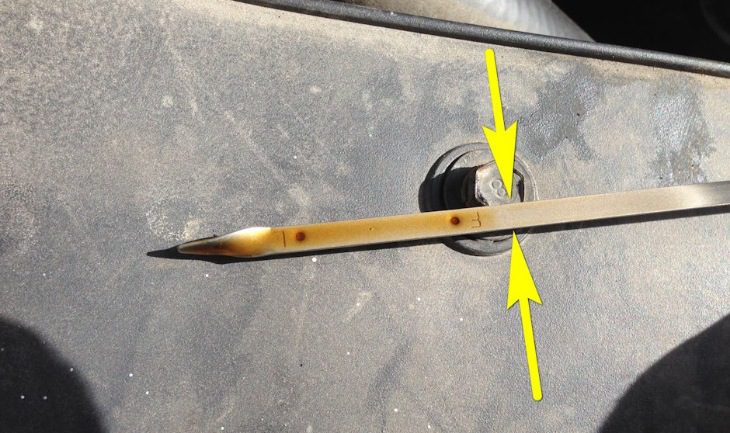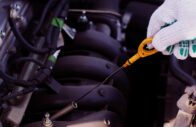
What happens if you pour oil in the engine above the level
Content
The danger of operating a car engine with a lack of oil is understandable to almost all drivers. But about exceeding the level, many have an erroneous opinion. The reason for this attitude is that the consequences of the overflow in the early stages of the development of the problem are invisible to most drivers. However, it was not by chance that the manufacturers supplied the motors with probes marked "min" and "max". Overfilling with oil is just as dangerous as underfilling, so it is better to immediately remove excess of more than 3-4 mm on the dipstick.

What is the danger of overflow
Many drivers believe that exceeding the oil level is temporary. In their opinion, after a short time, excess lubricant will burn out, and the level will return to normal values. But the danger is that during the period of natural "burnout" the oil will harm many parts of the engine. Regular overflow leads to the following phenomena:
- an increase in pressure on the gland and other seals and the occurrence of a leak;
- muffler clogging and the need to replace it;
- premature formation of excessive carbon deposits on the pistons and inside the combustion chamber;
- exceeding the load on the oil pump and reducing its resource;
- malfunction of the ignition due to salting candles;
- rapid wear of the oil filter;
- increased fuel consumption due to reduced torque.

All these consequences are intended and will not cause a sudden "death" of the motor. However, the risk of failure of parts increases significantly and threatens with serious material costs: the engine works worse and worse, the engine compartment becomes dirty and gradually corrodes.
Overflow reasons
The excess of the oil level is generally allowed when it is changed or topped up. In the first case, haste interferes. Incomplete drainage of the used oil by gravity leads to a delay of residues in the system. When the new portion is filled in at the rate, the old oil is mixed with the fresh one and the level is exceeded.
The topping-up operation is often used by the owners of cars with an oil-consuming engine. They carry out the procedure "by eye", so the overflow is inevitable. Another reason is mixing oil with unburned fuel. This happens with unsuccessful attempts to start the engine, most often in cold weather.
How to remove excess oil from the engine
You can remove excess oil in one of the following ways:
- Drain the oil from the system and fill it with a new portion at the rate.
- Partial drain. The drain plug is slightly unscrewed and waited until the oil begins to slightly undermine or flow in a thin stream. In this way, approximately 0,5 liters are drained, then a control measurement is carried out.
- Removal of excess with a medical syringe. You will need a dropper tube and a large syringe. Through a tube inserted into the dipstick hole, the oil is pumped out with a syringe.
Correct oil level check
Experts advise, during the active operation of the car, to make control measurements of the oil every 5-7 days. If the machine is rarely used, measurements are required on each trip. The behavior of car owners who wait until the low oil level warning light comes on is erroneous. This happens when the pressure drops to critically low levels and the engine can fail at any minute.

Motorists are divided over oil control methods. Some believe that the check should be done on a cold engine: the lubricant completely flows into the sump, which allows you to correctly assess the situation.
Opponents of the method believe that measurements on a cold engine are inaccurate, and there is a risk of overflow. This is due to the property of oil to shrink in the cold and expand when heated. Measurement and filling "cold" will lead to expansion of the volume during heating and leaks.
To eliminate errors, experts advise making measurements twice: on a cold and then on a warm engine. The procedure for checking the oil is as follows:
- The car is installed on the most level ground.
- The engine is warmed up to 50 degrees and turned off.
- The measurement is carried out in 10-15 minutes, when the grease completely drains into the crater.
- Remove the oil dipstick, wipe it with a dry cloth and set back until it stops.
- After 5 seconds, remove the probe without touching the walls.
Reducing the level to the “min” mark indicates that the oil needs to be topped up. Exceeding the "max" mark - that the excess must be removed.
The availability of high-quality lubricant in the required quantities is an important condition for the flawless operation of the engine. Given the risk of the consequences of a lack of or exceeding the permissible oil level, drivers should measure it in a timely manner and follow the recommendations of car manufacturers.
Video: engine oil overflow
Questions and answers:
What happens if the oil is poured into the engine above the level? In this case, the oil will be discharged into the crankcase ventilation system. This will lead to accelerated contamination of the crankcase filter (carbon deposits will appear on the mesh, which will spoil the ventilation).
What is the risk of engine oil overflow? Oil will enter the cylinders through the crankcase ventilation. Mixing with the air / fuel mixture, the oil will quickly spoil the catalyst and increase the toxicity of the exhaust.
Can I drive with overflowed engine oil? In many vehicles, slight overflow is allowed. But if too much oil is poured in, it is better to drain the excess through the plug in the sump.

